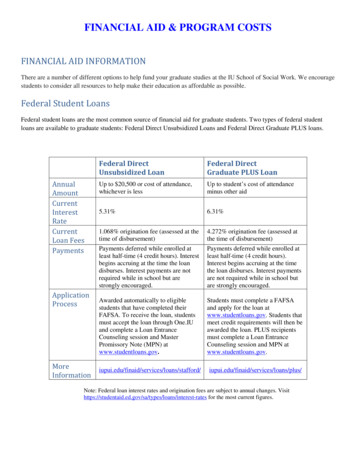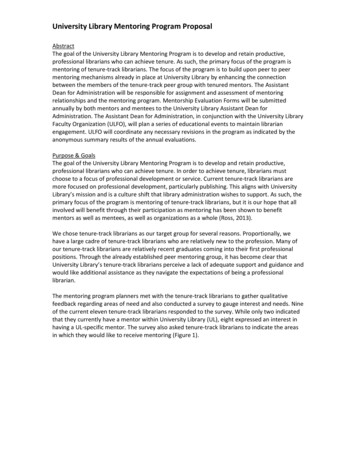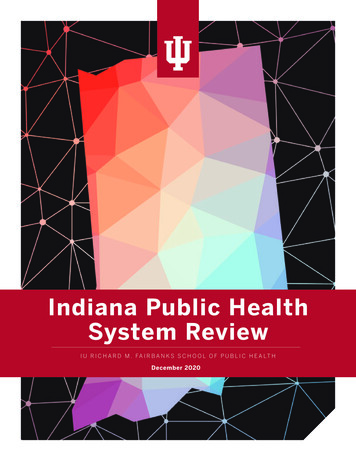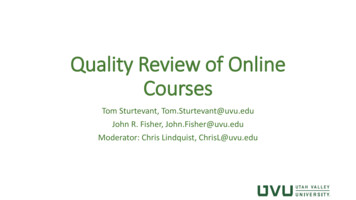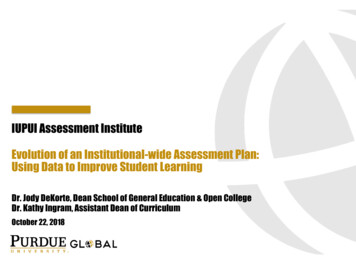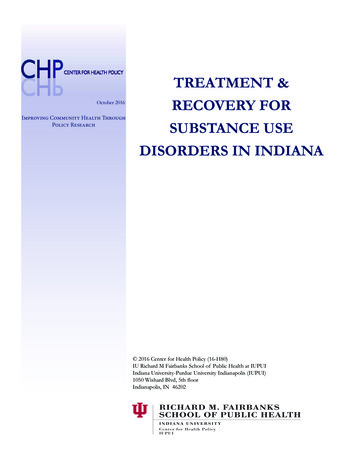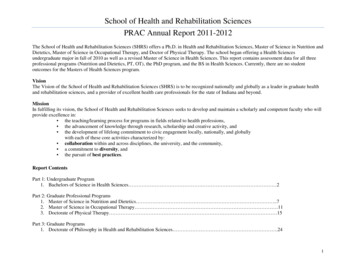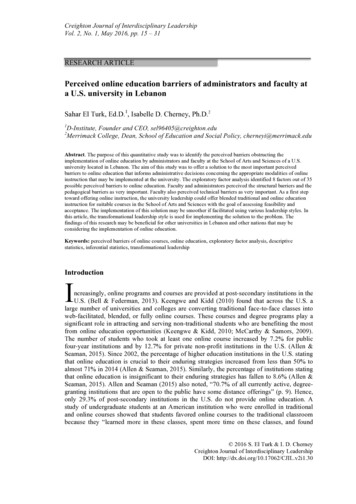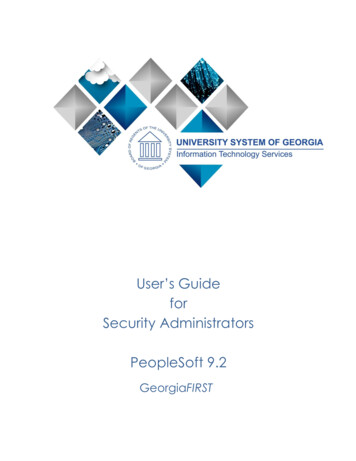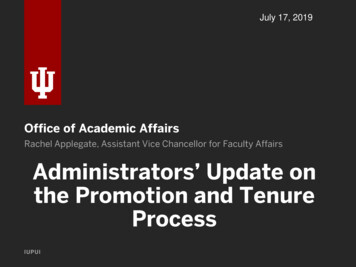
Transcription
July 17, 2019Office of Academic AffairsRachel Applegate, Assistant Vice Chancellor for Faculty AffairsAdministrators’ Update onthe Promotion and TenureProcessIUPUI
AgendaPart I: Overview of 2018-2019 Case TypesPart II: Changes to P&T GuidelinesPart III: eDossierPart IV: Specific Process IssuesPart V: Preview of 2019-2020 P&T Revision WorkPart VI: Programming for 2019-2020IUPUI
Part I: Overview of Case Types: from 20182019 cycle1. Types of Faculty2. Types of Cases3. Consistency/Agreement DataIUPUI
2018—2019 by the Numbers2018-2019 had more cases than 2017-2018 (142 compared to115), primarily due to an increase in IUSM clinical facultycases; 2019-2020 looks like approximately 140 cases. Thiscount does not include some cases that were withdrawn (1tenure case, several promotion cases.)
2017–2018: 115142 Cases Completed61 cases involved tenure48 to associate professor tenure5 to full professor tenure6 tenure-only2 to associate librarian32 tenure track promotion-only cases (promotion to full)49 non-tenure track promotion cases:34 clinical (28 to associate, 6 to full)8 senior lecturer7 research (6 to associate, 1 to full)IUPUI
Out of All Tenure Track Cases (93)All faculty:59 research cases (32 to associate, 17 to full, 6 tenure-only)18 service cases (10 to associate, 8 to full)8 teaching cases (5 to associate, 3 to full)6 balanced cases (1 to associate, 5 to full)Non-School of Medicine:36 research cases (23 to associate, 8 to full; 5 tenure-only)All teaching and all balanced casesSchool of Medicine:23 research cases (9 to associate, 13 to full, 1 tenure only)All service cases2 librarian cases (performance)IUPUI
Out of All NTT Cases (49)Research Scientists: 6 to associate, 1 to full 5 from School of MedicineClinical: 28 for service (23 associate, 5 full) all from School of Medicine6 for teaching (5 associate, 1 full) 2 from School of MedicineSenior Lecturer: 8 cases none from School of MedicineIUPUI
IUPUI
IUPUI
Note: The “Admin” boxindicates the President’s vote,which is the final result. “Split”means more than one negativevote and more than onepositive vote; it doesn’tnecessarily mean a completelyeven split of votes.Consistency Data: 2018–20197 cases that were not unanimously N
Consistency, 056030590Take-aways: Most cases are very well prepared and solid. It’s hard work, but done well.Most people who might have a ‘negative’ case for promotion tend to withdraw beforemaking it through the system.Looking over five years, the final, Presidential, vote always is consistent with at least oneprior level, and in virtually all cases, the final decision agreed with at least one facultycommittee vote. You cannot say that “if your dean likes you you’re fine” or “if your deanhates you you’re toast.”IUPUI
Part II: Changes to P&T Guidelines1. Changes to Required Information– Course listings– Grant reviews– Previous external letters for re-application2. Handling Questions about Candidate Materials– Affirmation of honesty– Asking for clarification– Use (or not) of external information sourcesIUPUI
About the changes, and their timingChanges are decided upon in spring of each year, after the conclusion of thecycle.In the past, changes were made in spring of Year 1 to go into effect in Year 3.That is, a change made in spring of 2015 (academic year 2014-2015) wouldnot apply for the 2015-2016 cycle, but in the 2016-2017 cycle.This spring, all of the changes (except one) were beneficial to the candidate,so the IFC Executive Committee implemented them immediately / asap.Side bar: How are changes made? In short, by consensus between the:Campus Promotion and Tenure Committee[1], the IFC Faculty AffairsCommittee[2], the IFC Executive Committee, and presented to the IFC. 1 &2 are represented on an special Ad Hoc Joint Committee to discuss P&Tissues.IUPUI
Timing of changesNo candidate will be penalized for not following the changes.Changes beneficial to the candidate: Not having to list courses prior to 2012 Not having to include unsuccessful grant reviewsCandidates MAY include that information. Removal of obsolete letters in cases of changing area of excellence, forpromotion casesWe expect this to be very rare.The other change: An honesty statement to be included in the candidate statement.This corrects an omission/oversight in our guidelines. If a dossier is submittedwithout that statement: Candidates can include it as a stand-alone document in the Supplementalfolder Candidates who do not include it will NOT be penalizedIUPUI
Changes: Reduction in RequiredInformationNo need to delete if it’s already thereCourse Listings: only 2012—presentFor faculty demonstrating satisfactory in teachingCourses have been auto-loaded into DMAIFaculty seeking promotion/tenure on the basis of excellence in teaching shouldcontinue to list all coursework (at least, all coursework in rank)Grant information: unsuccessful grant reviews no longer requiredCandidates can include these if they chooseChair needs to assess grant productivity/trajectory, if grant work isapplicable for the candidate’s position and caseIUPUI
Change: Special Case: Re-applying forPromotionCurrently: if reapplying for promotion within three years, you(administrator) must contact original external letter writers with the newmaterials; all previous letters must be preserved if not replaced by newletters.Now: if the area of excellence has changed AND the original writers doNOT revise, you (administrator) may remove the obsolete letters.ALWAYS: need 6 accurate, current (new OR revised), external reviews.IUPUI
The honesty statement: why?Problems with Candidate AssertionsExample problems: I hold this national office (but it isn’t listed on any webpage) I wrote this grant (but we know you were only a small part of this) I designed this program (but X person did more work than you did) This article is “in press” but the date is 2016 and there’s nothing thatcan be found at the journal siteResponse steps: Honesty affirmation Due process DocumentationIUPUI
Honesty StatementCandidates must include in their candidate statement:“I affirm that my statements in this dossier are a fair and accuratereflection of my achievements.”Chairs must check that this is includedFor the 2019-2020 cycle: if the candidate did not include this, they caninsert a stand-alone document into the Supplemental folder. If they donot, they will not be penalized.For 2020-2021, chairs should ensure that this is included before approvinga submitted dossier.Someday in the future we will try to have edossier have a check-box.IUPUI
Responding to Questions aboutCandidate AssertionsDue process:If a reviewer has a question, he or she should contact the committeechair. If it is substantive, the chair should contact the candidate:“This question has been raised. We would appreciate a response, by date.If you choose to respond, please upload your response in the Supplementalfolder. Please acknowledge that you have received this request.”Committees (or chair or dean) should be explicit in their reviews if theconcern, and response (or lack of a response) is important to the decisionthey make.IUPUI
Situation: Can a reviewer go wanderingaround the internets finding stuff about thecandidate? General answer, no they arenot required nor encouraged to do so.Keep the Focus on the Dossier!Questions about candidate statements are NOT the same as bringingnon-dossier information into the discussion.“I saw this news story: I wonder if it was our professor who did X”“I read this blog—it says Professor X is a wild person”Indiana University policy, ACA-37“The dossier constructed in consultation with the candidate provides theevidence upon which the tenure decision is to be made. If additionalinformation is sought or received during the review of the dossier at anylevel, the candidate and all previous committees and reviewers must benotified and given the opportunity to respond to the additionalinformation. The information and the responses shall then become part ofthe dossier.”IUPUI
Part III: eDossier1. No Technical Changes [mostly: routing to president, downloadbutton]2. Placing Information into Folders– Correct binning for NTT– Consolidation option– Avoid blank filesIUPUI
Behind the Scenes1. Promotion-only folders route only to the Chancellor level (not to thePresident)2. Download button– For campus reviewers only: Karen Lee Rachel Applegate For School of Medicine: Melody DarnallIUPUI
Placing Information into Folders1. For tenure track faculty something should be in each area– Tenure track faculty are required to be at least satisfactory in each area– Candidates are to substantiate all statements in the CV and candidatestatement with materials in the dossier2. For non-tenure track faculty they should NOT have information inareas that are not part of their appointment– Lecturers: Teaching and service– Clinical: Teaching and service– Research: Service onlyIUPUIYes to scholarshipNo to labelling it research
Advice to candidates:Those Pesky Folders1–DO use the list of foldersas a mental checklist oftopics that should beaddressed (somewhere).2–DO NOT (for the love ofyour reviewers) put blank ormeaningless documents intofolders (“See CV”).3–You CAN consolidate allinformation in each sectioninto one PDF.Candidates are notrequired to addressevery folder in everysection. It alldepends on thenature of their case.See ‘folder guides’ onthe OAA websiteIUPUI
Other tedious practices to avoid Merely pasting parts of the candidate statement or the CV into the dossierfolders is not useful. It makes the reviewers read the same things twice—twice the effort for no more reward. Instead, spend a sentence or a paragraph summarizing for the reviewer whatthat laundry list (from the CV) means: “The most important service I havebeen involved in is the IRB review committee, because ” The ‘discussion of the 3-5 most important works’ should not be a simplecopying of the articles’ abstracts. The discussion should succinctly conveythe importance of the work, the author’s individual role, and how the workrelates to the author’s trajectory (past and future). In general, raw materials go into Appendix folders. Do not include actualletters of thanks from students, clients, or colleagues in the main sections.IUPUI
What to do with the Folder Structure?BloomingtonIUPUI currentCVCVCandidate statements(on each area)[narrative, no lengthlimit]Candidate statement[narrative, 7 pgs total]Materials .syllabi, coursematerials .student evaluations .copies ofpublications .awardsIUPUIRegular folders:Analysis, summary[narrative keyevidence, 50 pagestotal]Appendices:MaterialsIUPUI future?Wondering if this wouldwork:CVCandidate statementMaterials--key (e.g. copies of3-5 publications)--supportingevidence
(Thinking about making changes?)The eDossier structure must:1. Convey the right information for all levels of review:– If information is needed at the departmental level—but largely ignored at thecampus level—we still need a place in edossier to place the information– President McRobbie interacts with dossiers from all campuses, so ours needsto provide information that he expects in somewhat the right format that heexpects2. Avoid encouraging or allowing duplicative or meaningless information3. Not involve too much clicking or uploading, by candidates or reviewers4. Be modified and maintained by university IT staff– The primary design function of eDossier was intended to be its routing system.Secure, confidential, and trace-able. that’s why we don’t use Box.IUPUI
Part IV: Specific Process Issues1.2.3.4.5.Constituting Ad Hoc P&T CommitteesHandling LETTERSEvaluation of Grant TrajectoryEvaluation of Dissemination OutletsBias TrainingIUPUI
Constituting Ad Hoc P&T Committees[Department] Chair responsibilities (p. 10 of P&T) “If the primary/department committee does not havefaculty/librarians at or above the rank sought by the candidate,establish a special primary committee that may include membersfrom outside the department, school, or campus. Such a committeeshould be composed in consultation with the duly constituted primarycommittee and should reflect disciplines as similar to the candidate’sas possible.” “If the candidate’s scholarship is interdisciplinary, team science, orpublic in nature, consider adding additional ad hoc members who canappreciate the interdisciplinary and collaborative nature of the work tobe reviewed to the primary/department committee for that case.Such ad hoc members should be added in consultation with the dulyconstituted primary committee.” Similar language is in the “Primary/Department Committee andUnit/School Committee” sectionIUPUI
Constituting Special / Ad Hoc P&T CommitteesThe Stuff of NightmaresIUPUI
Or, avoiding having the candidate have a heartattack when they see the signatures of themembers of the committee .Department ofTherapy*NewbieCurmudgeonIUPUI“Therapy” chosen as anexample because there areat least five schools atIUPUI which have someform of therapy program
Department ofTherapyI PUIArghSighOK Fine
Department ofTherapyNewbie is happy in their newdepartment.Department is too small to have a4-vote primary committee.NEW CHAIR has no idea aboutprior history or tensions feels thatCurmudgeon might be a GREATmember for the P&T committee!Department ofEquine StudiesNewbieWould not be“external”NewChair!CurmudgeonIUPUI
Keep in mind .If Curmudgeon had moved to Next State Over University, Newbie wouldcertainly have listed Curmudgeon as someone not to be used as an externalreviewer.Newbie will know the identities of the reviewing committee (will not know) theidentities of external reviewers.Chairs should be sensitive to personal and field-dependent histories. Manynew programs get developed specifically because people in traditionaldepartments think the new stuff is stupid.IUPUI
Adding Ad Hoc Members: Why1. The natural committee is too small to yield 4 votes: especially true forcases for promotion to full rank– The requirement is for four votes at each committee level. The votes donot need to be four-positive or four-negative; they could end up being twonegative two-positive. What you cannot have is three-votes and oneabstention.– In schools where P&T committees consist of “all eligible,” members shouldcarefully review where they are needed most—at the department or at theschool.– Where possible, prioritize voting at the level at which a member is mostclose to the discipline of the candidate. Campus and school reviewers relyon the department committees to provide the most disciplinary-specificreview of the case.2. The case involves interdisciplinary or public scholarship– Campus can help you identify potential reviewersIUPUI
Adding Ad Hoc Members: How (Who?)1. Joint responsibility of chair/dean and the natural committee members2. Not a responsibility of the candidate3. Candidate input:– Candidates can request exclusion of individuals from being externalreviewers– Candidates cannot request exclusion of natural committee members– No language exists to cover candidate exclusion of ad hoc committeemembersSuggest sensitivity to candidate inputSome reasonable categories of people cannot be external reviewers butcould be ad hoc reviewers: people from other IUPUI schools, people fromBloomington or Purdue-West Lafayette.IUPUI
Constituting Ad Hoc P&T CommitteesChair responsibilities (p. 10 of P&T) “If the primary/department committee does not havefaculty/librarians at or above the rank sought by the candidate,establish a special primary committee that may include membersfrom outside the department, school, or campus. Such a committeeshould be composed in consultation with the duly constitutedprimary committee and should reflect disciplines as similar to thecandidate’s as possible.” “If the candidate’s scholarship is interdisciplinary, team science, orpublic in nature, consider adding additional ad hoc members who canappreciate the interdisciplinary and collaborative nature of the work tobe reviewed to the primary/department committee for that case.Such ad hoc members should be added in consultation with the dulyconstituted primary committee.” Similar language is in the “Primary/Department Committee andUnit/School Committee” sectionIUPUI
Constituting Ad Hoc P&T Committeesin consultation with the duly constituted primary committeeIn practical terms, the department chair (or dean) will probably work withthe chair of the P&T committee to come up with names and thechair/dean will figure out schedules and availability of the potentialreviewers. The final committee must be acceptable to the ‘natural’committee members.IUPUI
Letters: Solicited LettersNot: External evaluationsNot: Candidate-solicited letters (those go in the dossier proper)Potential sources: Non-academic people able to give input into the candidate’s work Important academics who are not arms-length (co-authors, etc.) Special reviewers of particular aspects of the candidate’s position orwork(see next slide for more on this)Please refer in your (chair, dean, P&T committee) letter to theexistence and content of the solicited letters.IUPUI
Why solicited letters?Some people cannot be external reviewers: They are not at arms’ length: they were co-authors, or PIs. They are not at the right rank, title, or comparable institution: they may bethe leading person on that type of research, but not be an academic (sothey can’t speak to teaching or service). They may be clinical supervisors(but not tenure-track).Some people have particular and very important insights into the quality ofthe candidate’s work: They are community partners in public scholarship: they can testify as tothe impact of the work. They have been influenced in their practice by the innovations introducedby the candidate. They were mentees of the candidate and can describe their educationalexperienceIUPUI
Solicited letters—solicited by the chair(dean)Letters solicited by the candidate go into the regular dossier. Those lettersare inherently of lesser weight because they are presumably not objectiveand not systematic.Example: people who completed PhDs with the candidate as chairPresumably the candidate would only solicit letters from successful andhappy graduates; the candidate would only include letters that are positive.The chair can solicit from all or a systematic sample of Ph.D. graduates.IUPUI
Evaluation of Grant TrajectoryChange in requirements: candidates need not include unsuccessful grantreviews in their dossier.HOWEVER: where applicable, chairs and primary committees are requiredto “analyze the pattern of grant success.” Chairs should monitor grant activity throughout the candidate’s career Candidates should be encouraged to include important grantinformation. This can include ratings or reviews for unsuccessful grantapplications especially if they have not yet been successful.(Please clarify stature and status of grants for those not in your field:what is an R01? A K32?)IUPUI
Evaluation of Dissemination Outlets1. Chairs: pursue this dialogue with your candidates throughout theirannual reviews2. Consult with the University Library (Heather Coates) abouttraditional and “alt” metrics of item, journal, and venue quality3. Be sensitive to changing methods of dissemination– Maintain ‘peer review.’– A respected blog can be evidence of national reputation but is not initself a peer-reviewed venue. [nightmare scenario: anti-vax bloggers!]IUPUI
These three examples came tome during one weekThe Good, the Bad and the UglyThis is probably legit:my School doescomputing (even if Idon’t, and IEEE is arespectableorganization.Bad sign:they’llpubli
Jul 17, 2019 · IUPUI Consistency, 2014–2019 s ot e 554 6 560 e 6 24 30 560 30 590 Take-aways: Most cases are very well prepared and solid. It’s hard work, but done well. Most people who might have a ‘negative’ case for promot
